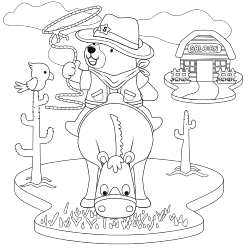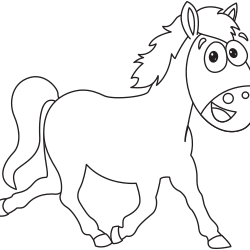Horses are the most popular animal on the planet, second only to cats. They have captivated the imaginations of people around the world since the 1500’s. From being shown in famous cartoons to books, to popular cartoons on television, horses captivate our imagination and make wonderful pictures for horse coloring pages. The picture of a happy, calm, elegant stallion in a gorgeous racing scene can brighten anyone’s day.





















Coloring is a great way for kids to relax and express their creativity. Whether it’s a horse coloring page or something more abstract, there are many options. So, why not give it a try?
KidsDrawingHub offers various coloring pages and drawing tutorials for kids to do on their own, or with a little help from their parents. Online coloring pages would be great if your child has just started to learn about colors. He/she would also make fun gifts for younger siblings who like horses as well!
Free, printable horse coloring pages provide an engaging way for children to learn to color. Colorful horses are a classic children’s favorite, so why not have them colorized? The opportunity to color horses in a fun, constructive manner that stimulates the imagination is very promising for young children. These coloring sheets come with directions for simple, even beginners to coloring to create a horse drawing on the page. Horses are so popular that they are easy to find, but a trip through the Internet will show that there are numerous websites that offer free horse coloring pages.
Printable Horse Coloring Pages for Kids
Free, printable horse coloring pages not only make learning enjoyable for children, they stimulate the brain while helping develop problem-solving skills. Colorful horses are an ideal subject for nursery-aged children because they are both cuddly and colorful. Most children love horses because of the attention they get from their parents when they ride them. Parents can use coloring sheets to encourage their toddlers to color. These horse coloring pages print free pictures of majestic horses that children can color to make their own personal horse drawings.
These types of printable horse coloring pages come with directions for simple, even beginners to coloring to create a horse drawing on the page. These pictures are great for coloring kids’ doggies or loungers. Horse coloring pictures can be used for imaginative play during Halloween and other holiday celebrations. Many people believe that horse coloring pictures are a key ingredient in children developing good motor skills, but some experts question this theory. While there is no scientific evidence that coloring pictures help children develop any kind of skill or abilities, it can be very exciting for children to color. Coloring is also a fun activity for families.
With the busy lifestyles most of us lead today, we often find ourselves bored or frustrated waiting for things to get done. Having fun coloring horse coloring pages to pass the time is a great alternative to sitting and doing nothing at all. Horse themed coloring pictures can provide hours of fun for children.
Unleash Your Child’s Creativity with Horse Coloring Sheets
Horses are majestic animals that have captured the hearts of many people, especially children. Their beauty, strength, and speed make them a favorite subject for artists and horse enthusiasts. If your child loves horses, they will enjoy coloring these horse coloring pages. These pages are perfect for kids who love horses and want to explore their artistic side.
- Running Horse Coloring Sheet: This coloring sheet depicts a horse running freely in an open field. Your child can color the horse’s mane, tail, and coat to make it look like their favorite horse breed.
- Jumping Horse Coloring Sheet: This coloring sheet shows a horse jumping over a fence. Your child can color the horse’s legs, hooves, and mane to create a sense of motion.
- Horse and Foal Coloring Sheet: This coloring sheet features a mother horse and her foal. Your child can color the two horses to create a sense of connection and bonding.
- Horse Head Coloring Sheet: This coloring sheet shows a close-up of a horse’s head, with its mane and face visible. Your child can focus on the horse’s intricate facial features, such as its eyes, nose, and mouth.
- Unicorn Coloring Sheet: This coloring sheet features a mythical creature, the unicorn, which is often associated with horses. Your child can use their imagination to color the unicorn’s coat, mane, and horn.
These horse coloring pages are a great way for kids to learn about horses and develop their creativity. They can use a variety of colors to make each horse, mane, and tail unique and special. When they are finished coloring, they can proudly display their artwork on the refrigerator or in their room. In conclusion, horse coloring pages are a fun and engaging activity that will entertain and educate your child about the beauty and grace of horses.
More About Horses
You can use these horse coloring pages to express yourself too. For example, if you have a friend who loves horses, you could draw two horses on top of one another, making a ring. Next, you would draw two small circles inside the ring. Next, use your white drawing pencils or colored pencils to draw some gently curved lines inside the ring to make it look more like a horse hoof. Then put this whole ring of colors inside the colored portion of the sheet.You can also use this horse coloring pages for other occasions.
Coloring horses can be used to show off your own personal style. If you’re into decorating, you can draw a variety of different breeds of horses and see which ones fit into your house the best. If there are only a few horses in your neighborhood, you can use this sheet to show off one horse in particular. It might be nice to have a wide range of different breeds so that people can choose the right horse for them.
The Wonderful World of Horses
Horses are some of the most beloved and iconic animals in the world. They are known for their beauty, strength, and grace, and have been domesticated by humans for thousands of years. Let’s explore the fascinating world of horses and learn about their history, breeds, anatomy, and more.
History of Horses
Horses have been a part of human history for over 6,000 years. They were first domesticated in Central Asia and were used for transportation, farming, and war. As humans spread throughout the world, they brought horses with them, and horses became an important part of many cultures.
Today, horses are used for a variety of purposes, including racing, sports, therapy and recreation. They were originally wild animals that roamed the grasslands of Asia and North America. Over time, humans learned to tame and train horses, and they became an important part of many cultures. Let’s explore the history of horses and their evolution from wild to domesticated animals.
Wild Horses
The ancestors of modern horses were small, dog-sized animals that lived over 50 million years ago. These early horses evolved over time, becoming larger and better adapted to running on open grasslands. By the time humans evolved, horses were already widespread across Asia and North America. These wild horses were hunted by early humans for meat and hides, and they were often depicted in cave paintings and other early art.
Domestication of Horses
Around 4,000 BC, humans began to domesticate horses. They found that horses were useful for transportation, farming, and war. Domesticated horses were smaller and more docile than their wild ancestors, making them easier to handle and train. The first domesticated horses were likely bred from wild horses that had been captured and tamed.
Horses in Different Cultures
Throughout history, horses have played an important role in many different cultures. In ancient Greece, horses were used in the Olympics and were considered sacred to the god Poseidon. In medieval Europe, knights rode horses into battle, and horses were a symbol of wealth and status. In the American West, horses were essential for transportation and ranching, and they were often depicted in Western art and literature.
The Industrial Revolution and Horses
With the rise of the Industrial Revolution in the 18th and 19th centuries, horses became even more important. Horses were used to power machines and transportation, and they were essential in farming and mining. However, as machines became more efficient, horses were gradually replaced by automobiles, tractors, and other machines.
Horses Today
Today, horses are primarily used for recreation, sports, and therapy. Horse racing is a popular sport, and horses are also used in show jumping, dressage, and other equestrian events. Horses are also used in therapy programs for people with disabilities and mental health issues.
Breed Types
There are many different breeds of horses, each with its own unique characteristics and features. Some of the most popular breeds include:
- Thoroughbred: Known for their speed and agility, Thoroughbreds are often used in horse racing and other sports.
- Quarter Horse: The most popular breed in the United States, Quarter Horses are known for their speed and versatility.
- Arabian: Originating from the Middle East, Arabians are known for their beauty, endurance, and intelligence.
- Appaloosa: Appaloosas have a distinctive spotted coat and are known for their versatility and endurance.
- Clydesdale: Clydesdales are large, strong horses often used in agriculture and as carriage horses.
Anatomy of Horses
Horses have a unique anatomy that makes them well-suited for their various purposes. Some of the key features of a horse’s anatomy include:
- Hooves: Horses’ hooves are made of tough, keratinized material and help them run and walk on various surfaces.
- Teeth: Horses’ teeth continue to grow throughout their life and are used for grinding and chewing.
- Mane and Tail: Horses’ manes and tails are made of hair and are used for protection and communication.
- Muscles: Horses have powerful muscles that allow them to run fast and pull heavy loads.
- Digestive System: Horses have a complex digestive system that is designed to process high-fiber plant material.
Behavior of Horses
Horses are social animals and have a complex social structure. They communicate with each other through body language, vocalizations, and scents. Horses are also sensitive to their environment and can become easily stressed or fearful. Proper care and training are important in keeping horses healthy and happy.
Conclusion
Horses are magnificent animals that have been a part of human history for thousands of years. By learning about the history, breeds, anatomy, and behavior of horses, children can gain a greater appreciation for these amazing creatures. Whether it’s the speed and agility of the Thoroughbred, the beauty and endurance of the Arabian, or the strength and versatility of the Quarter Horse, each breed of horse has its own unique characteristics and features. We hope you enjoyed learning about horses and their wonderful world.
